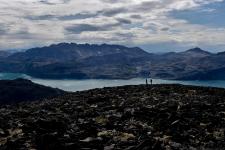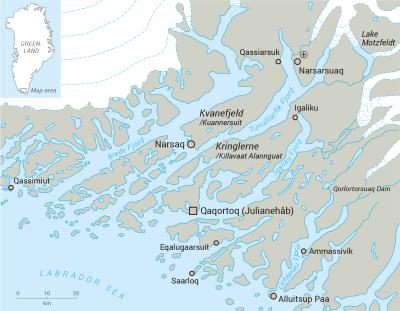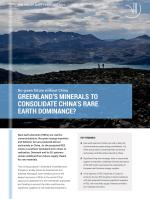Greenland’s minerals to consolidate China’s rare earth dominance?

- Rare earth elements (REEs) are vital to daily life, communications, green energy and defense. Yet, REEs and products containing REEs are almost exclusively controlled and produced by China.
- Significant long-term strategic state or supra-state support is required to challenge Chinese dominance of the REE sector and reduce the vulnerability of European and American energy supplies.
- In the absence of REE industries in Europe or America, the two REE projects in South Greenland, with their potential to become significant suppliers of REE, will most likely supply Chinese-controlled raw materials industries.
Rare earth elements (REEs) are vital for communications, the green energy transition and defense, but are produced almost exclusively in China. As the projected REE mines in southern Greenland inch closer to realization, Denmark and its EU partners remain sidelined from future supply chains for raw materials.
Two mining projects in Greenland, Kvanefjeld and Kringlerne, locally known as Kuannersuit and Killavaat Alannguat, have revealed some of the largest resources of rare earth elements in the world. If final approval is obtained from the Greenlandic authorities and funding is secured, the sites could become significant suppliers of raw materials essential to the growing electrification of transport, green energy, communications and defense systems. It remains to be seen, however, to what extent future mining of REEs in South Greenland will strengthen and secure European energy independence, or if REE mining in Greenland will galvanize the almost exclusive China dominated production and market.
In early September 2020, Tanbreez Greenland A/S was granted a mining lease for the Kringlerne REE project. Just a few weeks later, Greenland Minerals A/S reported that the Kvanefjeld REE project, just eight kilometres north of Kringlerne, had submitted a successful Environmental Impact Assessment and been cleared for its public hearing, the last step before a mining license can be issued.
Locally, there are concerns about the environmental impacts of future mining operations. In particular the Kvanefjeld project, which involves mining uranium as a by-product, is being criticized, as uranium mining remains a controversial and divisive subject in Greenland. However, many members of the Greenlandic political establishment see both projects as an opportunity to create much needed jobs and economic development, as well as being a long-term stepping-stone on the path to independence.
China as a green-energy superpower
China’s role as the world’s leading REE producer took off in the early 1980s, when the US Nuclear Regulatory Commission tightened restrictions on the mining and production of REE metals, causing the American industry to collapse. China stepped into the void and acquired the technology and the IP rights, while subsequently launching a national strategy to dominate production and the market in the REE sector. As a result, China today has the expertise, IP rights and production facilities, as well as its own REE-consuming industries. China also manufactures a significant and growing share of goods containing REEs, making it practically impossible for competing companies outside China to get a foothold.
China is making great efforts to maintain this economically important position, and it classifies the REE industry and related exports as strategic. As a result of this de facto monopoly, Western countries classify REE raw materials as critical, and various political initiatives have been launched to establish independent REE value chains. So far, however, they have been unsuccessful, and many European companies engaged in the current green transition rely on continuous Chinese supplies of products containing REEs.

REEs essential for green and defense technology
REEs occur everywhere in modern technology and are indispensable for the transformation of the energy and transport sectors. With the effects of climate change gathering pace, the demand for sustainable energy and REE-dependent products, which are vital to renewable energy solutions, is only likely to increase. REEs are also essential for magnets in electric vehicles. The market share of electric vehicles is still small but growing fast. By 2040, electric vehicles are projected to make up more than half of all new vehicles sold. Although all types of vehicles use REEs in electronic equipment, an electric car uses about a kilogram of REE for the engine alone, and offshore wind turbines about 200 kilos per megawatt.
Furthermore, REEs are playing increasing roles in European and US military technology, being used in warships, fighter planes, aerospace technology, surveillance, lasers, etc. According to a 2020 NATO report on energy security, an American submarine of the Virginia class requires about 400 tons of REEs, an Arleigh Burke-class destroyer more than two tons and an F-35 fighter plane 400 kilos. This demand may in fact be even more challenging than it looks in relation to yearly global production, since certain sector-specific REEs are in greater demand than others. As the NATO report states, ‘The more sophisticated the military equipment becomes, the more diverse is the demand for rare earths for the armed forces (...) However, at present, NATO’s import dependency on China’s REE is nearly 100 percent.’
What are rare earth elements?
Rare earth elements comprise a group of seventeen elements that occur jointly in nature due to their chemical and physical similarities. REEs are in fact less rare than many commonly mined metals such as gold, silver and platinum. Their misleading label dates back more than two hundred years, when the first REE (yttrium) was discovered in Sweden, at a time when ‘rare’ simply meant ‘extraordinary’.
Hundreds of individual REE minerals are known, although only a few are commercially attractive. Economically the magnet sector dwarfs the other REE-consuming sectors, as it represents 79 percent of the global market value of REEs, which is worth USD 2.2 billion, but only about 29 percent of global volumes. Consequently, the mineral prospects that attract the greatest investment interest are those projects that are most closely aligned with the specific demands of the magnet sector. Production of REEs thus entails both high-priced and low-priced elements due to the natural distribution of REE. This fact is a key economic parameter for any new REE mining project.
The REE market is a specialty market, characterized by business-to-business trade – and dominated by domestic Chinese trade – rather than by the metals exchanges. REE raw materials and products are tailored to fit the specific demands of REE-consuming sectors, such as transport, communications and defense, and generally no substitutions are applicable. The vast majority of these products are manufactured in China, and subsequently the vast majority of REEs are exported embedded in high-tech components and goods, thus boosting both their value and the Chinese economy.
The firm Chinese grip on the global REE market, including control of REE technologies, production capacities, IP rights, comprehensive value chains, export quotas and price controls, are efficient obstacles to the development of a free market in REEs
No geological shortage of REEs
The US Geological Survey conservatively recorded a global reserve of 120 million tons of REEs in 2019, which does not include Greenland’s reserves. Assuming annual REE consumption over the next few years doubles and reaches about 500,000 tons a year, this amount alone is sufficient for roughly 250 years. Therefore, although the REE raw material market is critical in Europe and the US, this is due to the current Chinese dominance of the sector, not to any global shortage of REE minerals, nor to present production constraints in the mining sector.
The annual demand for REEs, currently about 200,000 tons a year, can be supplied by a handful of large mines (Kvanefjeld plans to produce about 30,000 tons a year). In other words, the projects in Greenland, and another fifteen or so advanced mining projects outside China, are not responding to an unmet demand. In fact, the market cannot accommodate the quoted output of all the planned projects.
Both Greenlandic REE projects claim to have robust business cases enabling them to cope with requirements such as ore quality, low operating costs and attractive logistics. Given the Chinese dominance of the market, however, new mines are also dependent on long-term off-take agreements with Chinese industrial groups, since REE-processing capacity and industrial demand outside China is negligible.
Consequently all existing REE mines outside China, except for those in Russia and the Mount Weld mine in Australia, export their minerals or concentrates to China. In line with this reality, Greenland Minerals A/S has established ties with the Chinese industry by selling 10.5 percent of its shares to the Shenghe Resources Holding Co. Ltd. Tanbreez Greenland A/S, however, has indicated an intention to supply European plants, though there are currently no adequate production facilities or market sectors.
Though the current structure of the REE industry from mining to end-product and its importance remains critical to the European and American industries, there is no short-term solution to easing the risk of supply to industries and defense systems being disrupted. The firm Chinese grip on the global REE market, including control of REE technologies, production capacities, IP rights, comprehensive value chains, export quotas and price controls, are efficient obstacles to the development of a free market in REEs. China thus retains control over access to REEs and has in the past used that power to exert pressure on political rivals. The threat of a disruption to supplies has acquired new urgency in Brussels recently. Last autumn, therefore, Internal Market Commissioner Thierry Breton announced a new ‘raw material alliance’ to ‘increase EU resilience in the rare earth and magnet value chains’.
In conclusion, the availability of giant REE reserves alone does not guarantee a successful business case for new mining activities. Accordingly, even though the Greenlandic deposits possess attractive ore quality and large ore reserves – probably among the top three in the World – they are not likely to reduce the risks to European or American supply. To do so would require significant long-term state or supra-state strategic investments in developing industries that refine or use REEs.
Authors: Per Kalvig, Chief Adviser, Geological Survey of Denmark and Greenland (GEUS/MiMa), pka@geus.dk Hans Lucht, Senior Researcher, DIIS, halu@diis.dk
DIIS Experts



